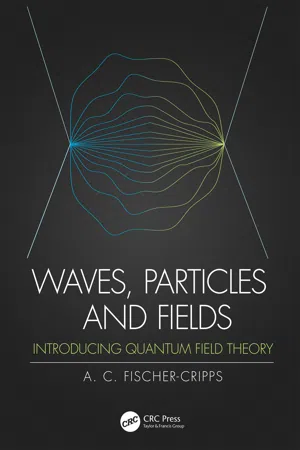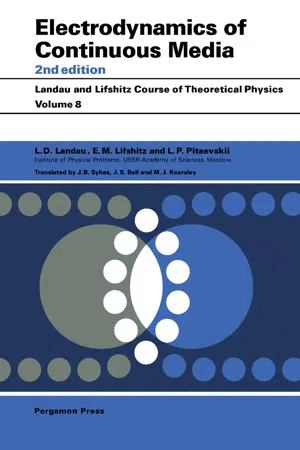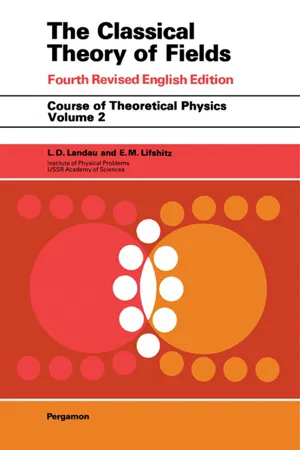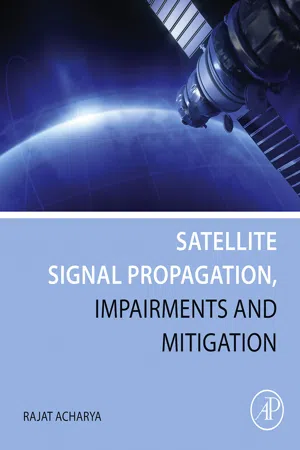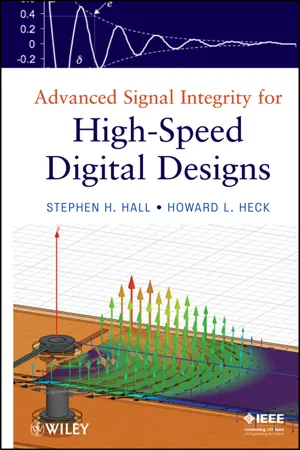Physics
Magnetic Scalar Potential
The magnetic scalar potential is a concept in physics that describes a scalar field used to simplify the mathematical description of magnetic fields. It is related to the vector potential and is used in the context of magnetostatics to represent the magnetic field in a region of space. The magnetic scalar potential is particularly useful in solving problems involving magnetic fields and their interactions.
Written by Perlego with AI-assistance
Related key terms
Related key terms
1 of 4
Related key terms
1 of 3
5 Key excerpts on "Magnetic Scalar Potential"
- eBook - ePub
Waves, Particles and Fields
Introducing Quantum Field Theory
- Anthony C. Fischer-Cripps(Author)
- 2019(Publication Date)
- CRC Press(Publisher)
If we take the reference point at infinity, then: φ x, y, z = q 4 π ε 0 r (15.16) That is, the scalar potential is a scalar field. It is a function of position only for a static field. 15.3 The Vector Potential For a magnetic field, Gauss’ law states that: * ∇ → ⋅ B = 0 (15.17) As well, from Ampere’s law, in the absence of any changing electric field: ∇ → × B = μ 0 J (15.18) This is slightly different from the case of an electric field. Maxwell’s equations are not quite symmetric in their expressions of E and B fields and this arises due to the physical existence of isolated electric charges whereas there are no isolated magnetic “charges”. Just as E is the gradient of a scalar potential, we would like to express B as the gradient of some kind of potential. This potential cannot be a scalar potential because if it was, the divergence would not be zero and the curl would be zero. In this case, the curl of a magnetic field is not zero. Since the divergence of B is zero, then this means that B must be equal to the curl of another field. This other field is called a vector potential field and is given the symbol A. That is: Since: ∇ → ⋅ B = 0 (15.19) then: ∇ → ⋅ ∇ → × A = 0 (15.20) and so: B = ∇ → × A (15.21) A is the vector potential. It is a three-vector. 15.4 Maxwell’s Equations in Potential Form 15.4.1 Maxwell’s Equations and the Vector Potential As shown in the previous section, the electric field E can be represented by the gradient of a scalar potential ϕ. E = − ∇ → φ (15.22) From Gauss’ law, we have the divergence of E being equal to the charge density: ∇ → ⋅ E = ρ (15.23) In the case of a steady magnetic field, we have B expressed as the curl of a vector potential A. B = ∇ → × A (15.24) And from Gauss’ law for magnetism: ∇ → ⋅ B = 0 (15.25) If we make the substitutions into Faraday’s law, we - eBook - ePub
- L D Landau, J. S. Bell, M. J. Kearsley, L. P. Pitaevskii, E.M. Lifshitz, J. B. Sykes(Authors)
- 2013(Publication Date)
- Pergamon(Publisher)
J/c. Hence the potential changes by this amount on each passage round a contour enclosing a linear current, i.e. it is a many-valued function.If the currents lie in a finite region of space (and μ = 1 everywhere), the vector potential of the magnetic field at a great distance from the conductors isA = M × R/(30.16)R 3,(30.16)whereM =(30.17)∫r × jd V / 2 c(30.17)is the total magnetic moment of the system.†For a linear current, this becomesM = J∮/2 c ,r × d 1and can be transformed into an integral over a surface bounded by the line of the current. The product is equal in magnitude to the area of the triangular surface element formed by the vectors r and d1 . The vector ∫df is independent of the particular surface (bounded by the current) over which it is taken. Thus the magnetic moment of a closed linear current isM = J(30.18)∮ df/ c .(30.18)In particular, for a plane closed linear current the magnetic moment is simply JS/c , where S is the area of the plane enclosed by the current.To conclude this section, we may briefly discuss the energy flux in a conductor. The energy dissipated as Joule heat in the conductor is derived from the energy of the electromagnetic field. In a steady state, the equation of continuity which expresses the law of conservation of energy is - eBook - ePub
- L D Landau(Author)
- 2013(Publication Date)
- Pergamon(Publisher)
A . A constant electric field is equal toE = − grad ϕ.(19.1)(19.1)Thus a constant electric field is determined only by the scalar potential and a constant magnetic field only by the vector potential.We saw in the preceding section that the potentials are not uniquely determined. However, it is easy to convince oneself that if we describe the constant electromagnetic field in terms of potentials which do not depend on the time, then we can add to the scalar potential, without changing the fields, only an arbitrary constant (not depending on either the coordinates or the time). Usually ϕ is subjected to the additional requirement that it have a definite value at some particular point in space; most frequently ϕ is chosen to be zero at infinity. Thus the arbitrary constant previously mentioned is determined, and the scalar potential of the constant field is thus determined uniquely.On the other hand, just as before, the vector potential is not uniquely determined even for the constant electromagnetic field: namely, we can add to it the gradient of an arbitrary function of the coordinates.We now determine the energy of a charge in a constant electromagnetic field. If the field is constant, then the Lagrangian for the charge also does not depend explicitly on the time. As we know, in this case the energy is conserved and coincides with the Hamiltonian.According to (16.6) , we haveE =(19.2)+ e ϕ .mc 21 −υ 2c 2(19.2)Thus the presence of the field adds to the energy of the particle the term eϕ, - Rajat Acharya(Author)
- 2017(Publication Date)
- Academic Press(Publisher)
dσ across the unit length isd U = E d σ= Eɛ 0d E(2.11a)Then, the total work done U 1 , in separating them across a unit length to finally generate field E isU E =∫ 0 EɛEdE=1 2ɛE 2(2.11b)The definite integral limits between zero as the initial field, when there is no separated charge to the final value E and the complete field has been developed inside the volume considered. Thus, we get the energy density in an electric field at a point with intensity E as U =½ɛE 2 .2.3.3.2 Magnetic vector potential A and magnetostatic energy
Unlike the electric field, the magnetic field cannot be defined as a gradient of a scalar potential. This is because, for a field to be expressed as gradient of a scalar, it must be curl free. But B is not curl free, in general, i.e. ∇×B ≠0. But, B is divergence free, i.e. ∇⋅B =0. So, considering the fact that ∇⋅∇×A =0, where A is any arbitrary vector, we can always represent B as the curl of a vector. So, we can always define a vector A , such that,B = ∇ × A(2.12)A is called the magnetic vector potential for the field B . We shall now go a little bit more deep into this term to understand what exactly this magnetic vector potential means. Whenever a current flows through a conducting loop, it generates a magnetic field and the loop acts like a magnetic dipole. Now, let us consider, there is already a magnetic field present in the region with magnetic induction B and an infinitesimally small current carrying loop is brought to a definite point P in this field. If the magnetic dipole moment of ths loop is dμ (remember, it is different from the magnetic permeability), it can be shown that, in terms of the loop parameters, the moment d μ can be represented as d μ =Id S . Here, I is the current carried by the loop and d S is its area. d μ will naturally tend to align along B when the loop is set free. Moving the loop needs external work to be done against the torque acting upon it in this condition. So, the maximum potential energy that it can have at this point P is dU =d μ ⋅B =Id S ⋅B . In this condition, the moment μ is directed in direction opposite to the direction of the field, B . It will have minimum potential energy and zero torque when the dipole direction is aligned with that of the magnetic field. These are shown in Fig. 2.7- Stephen H. Hall, Howard L. Heck(Authors)
- 2011(Publication Date)
- Wiley-IEEE Press(Publisher)
magnetic vector potential . The magnetic vector potential is used to calculate inductance, which is in turn used to calculate the energy stored in a magnetic field.The basic laws that rule magnetostatics are the time-invariant forms of Ampère’s and Gauss’s laws for magnetism:(2-82a)(2-82b)If the following vector identity is applied (from Appendix A),it implies that can be written in terms of the curl of a vector . This is called the magnetic vector potential , which sometimes helps to simplify calculations such as inductance:(2-83)To calculate the form of , it is first necessary to introduce the most basic law of magnetostatics, the Biot-Savart law , which describes how the field at a given point is produced by the moving charges in the vicinity of that point. During application of this law, we consider currents that are either static or very slowly varying with time. The Biot-Savart law is given by [Inan and Inan, 1998](2-84)where I is the current, a unit vector pointing from the location of the differential current element Id to the point P , and R = the distance between the current element and point P . Note that a primed quantity represents the position vector or the coordinates of the source points and the unprimed quantities represent the position vector or the coordinates of the point where is being evaluated. Note that the cross product in (2-84) indicates that d is perpendicular to both Id and , with the orientation being described by the right-hand rule. Also note that the field generated by Id will fall off with the square of the distance.Note that the current element Id is a small part of a closed current loop and that an arbitrarily shaped loop can be constructed by the superposition of many such closed elemental loops of current, as shown in Figure 2-18 . Subsequently, the Biot-Savart law can be written in terms of an integral:(2-85)Careful observation of (2-85) allows us to calculate the form of the magnetic vector potential . Equation (2-83) states that the magnetic field is the curl of . The trick is to manipulate (2-85) into the form of a curl so that can be found. The right-hand term of (2-85)
Index pages curate the most relevant extracts from our library of academic textbooks. They’ve been created using an in-house natural language model (NLM), each adding context and meaning to key research topics.
Explore more topic indexes
Explore more topic indexes
1 of 6
Explore more topic indexes
1 of 4
